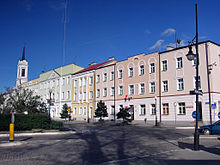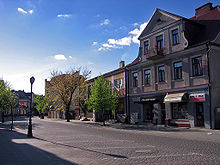Ostrołęka
| Ostrołęka | ||
|---|---|---|

|
|
|
| Basic data | ||
| State : | Poland | |
| Voivodeship : | Mazovia | |
| Powiat : | District-free city | |
| Area : | 33.46 km² | |
| Geographic location : | 53 ° 5 ' N , 21 ° 35' E | |
| Residents : | 52,071 (Jun. 30, 2019) |
|
| Postal code : | 07-400 to 07-417 | |
| Telephone code : | (+48) 29 | |
| License plate : | WHERE | |
| Economy and Transport | ||
| Street : | Suwałki - Warsaw | |
| Next international airport : | Warsaw | |
| Gmina | ||
| Gminatype: | Borough | |
| Surface: | 33.46 km² | |
| Residents: | 52,071 (Jun. 30, 2019) |
|
| Population density : | 1556 inhabitants / km² | |
| Community number ( GUS ): | 1461011 | |
| Administration (as of 2012) | ||
| Mayor : | Łukasz Kulik | |
| Address: | pl. Gene. Józefa Bema 1 07-410 Ostrołęka |
|
| Website : | www.ostroleka.pl | |
Ostrołęka ( German Ostrolenka, 1941-1945 Scharfenwiese ) is an independent city in Poland in the Masovian Voivodeship .
Geographical location
Ostrołęka is located on the Narew , Omulew and Czeczotka rivers.
history
In the 11th / 12th In the 16th century there was a castle and a market settlement on the left bank of the Narew on the site of today's Ostrołęka . It was strategically located on the trade routes between Mazovia and Prussia . The Kulm town charter was confirmed on May 12, 1373, the first award probably took place earlier. Crafts developed in the city in the 15th and 16th centuries. In 1526 the city came under the Polish crown together with the Duchy of Mazovia . Its importance as an economic center continued to grow, and the city became an important supplier of cloth and wood products to Gdansk . The goods were mainly transported there by river.
The city's growth was slowed when the plague broke out in 1563 and shortly afterwards a fire destroyed large parts of the city. Between 1655 and 1660 the city was plundered and destroyed by the Swedes . Not far from the city, the Kurpies waged a battle against the Swedes. In 1777, 1,674 people lived in the city, making it the third largest city in Mazovia after Warsaw and Pułtusk . During the Third Partition of Poland , the city fell to Prussia . On February 16, 1807 Napoleonic troops defeated the Russian troops in the Battle of Ostrołęka here . Ostrołęka owes this battle an entry on the triumphal arch in Paris.
In 1807 the city came to the Grand Duchy of Warsaw and in 1815 to Congress Poland . During the November uprising in 1831 there was a battle between Polish and Russian troops , as a result of which parts of the city were destroyed. In 1893 the city was connected to the rail network. This gave her a direct connection to Warsaw and Saint Petersburg . In 1897 the rail network was expanded to Tłuszcz . In addition to the approximately 8,000 inhabitants, about 5,000 Russian soldiers lived in the city.
During the First World War and the Polish-Soviet War that followed in 1920 , the city was one of the cities most severely affected by destruction. During the Polish-Soviet War, the city was captured by Soviet troops on August 7, 1920 . However, they had to leave the city on August 23.
Since the end of the First World War the city belonged again to Poland and there to the Białystok Voivodeship . In early 1939 it became part of the Warsaw Voivodeship .
During the Second World War the city was from the Third Reich occupied and there were labor camps built. Ostrolenka became the seat of the German district Scharfenwiese and the place name was changed to Scharfenwiese in 1941 . After the liberation of the city by the Red Army , the city became the seat of a powiat . In an administrative reform in 1975, the city became the seat of the Ostrołęka Voivodeship , and in another administrative reform in 1999, the city lost its status and became part of the Masovian Voivodeship .
Population development
| year | Residents | year | Residents | year | Residents | year | Residents |
|---|---|---|---|---|---|---|---|
| 16th Century | 2,000 | 1777 | 1,674 | 1808 | 2,036 | 1829 | 2,883 |
| 1897 | 7,965 | 1913 | 13,500 | 1915 | 5,000 | 1937 | 13,650 |
| 2000 | 55,818 | 2005 | 54,129 | 2014 | 52,792 |
Economy and Infrastructure
On the northern outskirts of the city there are two large industrial plants, a paper mill founded in 1959 , which today belongs to the Stora Enso Group , and a large coal-fired power station . Unit A of the power plant opened in 1956, Unit B in 1972 and Unit C in 2015.
The Ostrołęka station in a major hub following railway lines:
- East to Łapy and Białystok on the Petersburg-Warsaw Railway , with a branch line to Łomża
- South to Tłuszcz and Warsaw
- Head southeast to Małkinia Górna
- Northwest to Willenberg and Ortelsburg
Ostrołęka is the starting point of National Road 53 , and National Road 61 and provincial roads 544 and 627 also pass through the town .
Town twinning
- Meppen (Germany), since 1994
- Cafelândia (Brazil), since 1999
- Balassagyarmat (Hungary), since 2000
- Alytus (Lithuania), since 2001
- Masty (Belarus), since 2002
Buildings
- Parish church (14th century)
- St. Bernard Monastery (17th century)
- Town hall (19th century)
- Post Office (19th Century)
Personalities
sons and daughters of the town
- Wiktor Gomulicki (1848-1919), writer
- Alexander von Wrangell (1896–1987), German farmer and politician
Honorary citizen
- Ryszard Kaczorowski (1919–2010), the last Polish President in exile, made an honorary citizen in 2000
Web links
- Ostrołęka City website (multilingual)
- Portrait of the city of Ostrołęka on the website of the twin city Meppen
Individual evidence
- ↑ a b population. Size and Structure by Territorial Division. As of June 30, 2019. Główny Urząd Statystyczny (GUS) (PDF files; 0.99 MiB), accessed December 24, 2019 .




